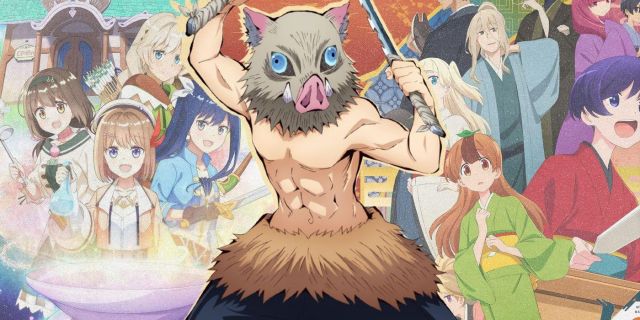Demon Slayer takes place in the Taisho era, which lasted from 1912 to 1926, an era of rapid change in Japan. The nation was industrializing and modernizing like never before, and it seemed like the old ways were rapidly fading away. Demon Slayer’s main characters saw that for themselves, such as Tanjiro staring in wonder at Tokyo’s electric lights and 1910s-era cars.
That went double for the wild Inosuke Hashibira, who was raised by animals and barely understands modern civilization at all, let alone technology like cars and trains. Inosuke was almost like an isekai protagonist — a bewildered being thrust into a strange new world and given no choice but to adapt to it. In a way, Inosuke is a partial isekai character; a fish out of water trying to make sense of the bizarre new world around him. Moreover, he’s not the only one.
How Inosuke Hashibra Became a Man of Two Worlds

Demon Slayer isn’t an actual isekai anime, but it does have some partial isekai elements to it, which enriches the story without getting too many tropes or clichés involved. The core idea of isekai is having the protagonist end up in an unfamiliar world, and fans may watch that hero adjust to their new surroundings and get the lay of the land. It’s escapism at its finest, such as Japanese teens ending up in a fantasy kingdom or game world. Recent anime titles like Demon Slayer integrated the basic “hero in a strange world” idea and made it a natural part of the story, and it has surprising thematic depth for Inosuke.
Inosuke isn’t used to human company, and he enjoys it more than he’d admit. The creative tsundere Inosuke is fascinated not just by cars and trains, but also by genuine human bonds. He’s gone from a world of forest animals to cities and towns of people, creating a new “ecosystem” where he can finally integrate with more of his kind. Inosuke longed for human contact, it seems, based on how much he enjoys having Tanjiro praise him. Inosuke also has fun competing with Tanjiro and the other slayers, getting himself used to other humans and testing himself against them. Evidently, he was secretly lonely in the forest, and transitioning to the human world made him much happier and better adjusted. He’s come a long way since his brutal first impression at Kyogai’s house.
Inosuke’s soft isekai adventure also highlighted the rapid changes taking place across Japan. In the Taisho era, one might say there are two Japans, with one being a rustic, traditional world in the countryside and the other being a high-tech, modern world like in Tokyo. Tanjiro and Inosuke both stepped into new worlds in Tokyo and aboard the Mugen Train, which represents how the old Japan is fading away and a modern one is replacing it. Inosuke went from the old world to the new — a jarring change that’s borderline isekai without the benefit of Truck-kun or a reincarnation goddess like Melfina. Inosuke could always go back to his rustic countryside, but eventually, that world will be gone, replaced with telephone poles, cars and light bulbs. When that happens, Inosuke’s soft isekai journey will become more permanent.
Soft Isekai Adventures in Other Anime Titles

Inosuke isn’t the only anime character who’s challenged to reinvent themselves by visiting a new, unfamiliar part of their own world. The “soft isekai” concept is also found in Fall 2022 anime titles like My Master Has No Tail and Management of a Novice Alchemist, which likewise have trace elements of “cute girls doing cute things” to them. Novice Alchemist isn’t truly isekai, but it does show the teen girl Sarasa Feed traveling from the bustling capital city to the tiny, rural Yok Village, a place where she knows nothing and no one. Sarasa must build a successful alchemy shop there, effectively restarting her life with a new village, new neighbors and new challenges. Sarasa is up for this, and she embraces the power of friendship and the entrepreneurial spirit to make the most of her new “world.” It’s isekai without the tiresome clichés.
Meanwhile, My Master Has No Tail features its own Inosuke — a cheerful tanuki girl named Mameda who also lives in the Taisho era. She is used to the old-fashioned, tradition-bound world of Japan’s countryside, such as tanuki tricks and demon parades, but 1910s Osaka is a whole different world. Mameda experienced serious culture shock during her soft isekai journey to the big city; a place of not just kimonos and markets but also cars, trolleys, and Western-style suits and hats. Mameda was in over her head at first, but she met this bizarre challenge with sheer creativity and force of will. She will become a rakugo star, all while learning just how much larger and stranger Japan really is from her point of view. Like most isekai heroes, Mameda is restarting her life in an unfamiliar world with unfamiliar rules, but for her, that’s an opportunity for growth, not a reason to flee.















Leave a Reply